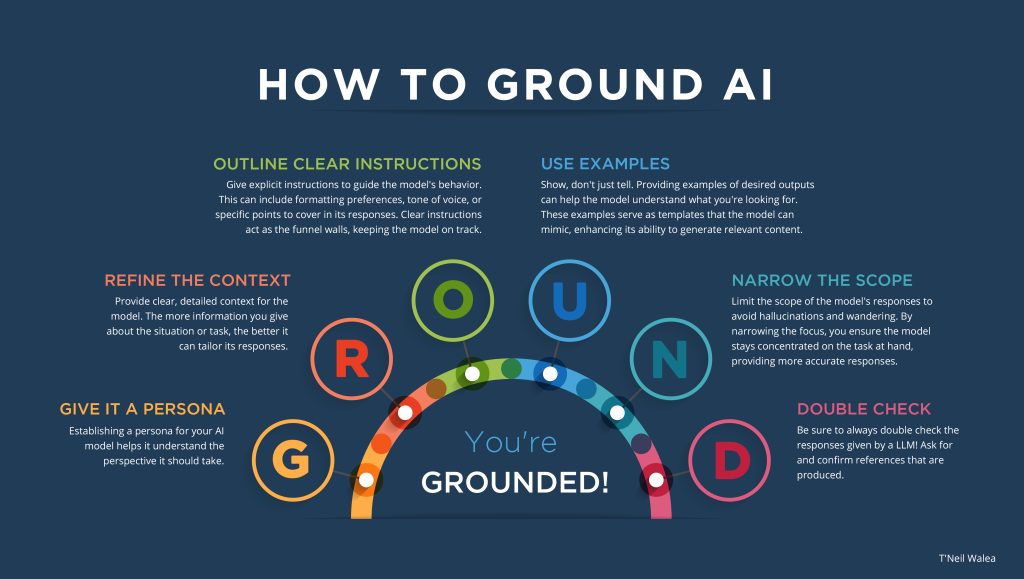The Importance of Grounding AI Models and How to Do It Well
“You’re grounded” …the two most dreaded words for every teenager. (Side note: It’s funny how time progresses and having an evening at home without a phone sounds pretty nice! But I digress.)

Painful teenage memories notwithstanding, being grounded is the key to honing your interactions with AI models. With the proliferation of OpenAI’s ChatGPT, Google’s Bard, and Microsoft’s Copilot into so many areas of life, learning how to achieve the results you need from artificial intelligence requires learning how to write quality prompts and ensure the large language model (LLM) is producing content in the correct voice, pulling from the correct data, and speaking to the correct audience.
Why Model Grounding is Necessary
Let’s talk about the prompt-engineering process called grounding.
Grounding gives the LLM a frame of reference from which to approach the content. The guidance I give users is to visualize the prompt-writing process as a funnel. Grounding an LLM narrows down the vast possibilities of responses and tailors the model to produce relevant and accurate responses based on your specific needs.
Think of trying to produce meaningful content with AI like trying to fill a small-mouthed glass bottle with a wide-open water hose. The sheer volume makes precision difficult. Information flows in all directions, and it’s chaotic and hard to manage. By guiding the model to respond as an expert in a certain field, or to reference a document of proprietary information, or tailor the response to a certain end user, we funnel the final product into a manageable and relevant stream. Grounding is what we call the funneling effect that channels the produced information down to concise and useful content.
Here are a few ways grounding an AI model helps produce precision content:
1. Enhancing relevance — Make the AI an expert! By grounding the model you ensure the responses are pertinent and relevant to your specific field and task.
2. Improving accuracy — The model’s ability to provide correct information increases when it is well-grounded. Tell it websites to reference or Executive Orders to review and watch the accuracy scale exponentially!
3. Boosting efficiency — You already work hard; being grounded lets you work more efficiently. A grounded model can perform tasks more effectively, saving time and resources.
4. Reducing ambiguity — Grounding helps minimize vague or irrelevant answers, making the model’s response more useful and relevant to your query.
Now that we’ve covered why grounding is so important, let’s talk about the “how to” specifics. Since we are in the high school flashback mindset, let’s make an acrostic to get better at getting grounded. (Be sure to save the graphic below!)
How to Ground a Large Language Model
G: Give it a Persona
Establishing a persona for your AI model helps it understand the perspective it should take. Whether it’s a Federal customer service representative, a technical advisor, a warfighter, or a public health expert, defining the personas of both the content producer and the end consumer of the content makes the responses more consistent and aligned with the role.
R: Refine the Context
Provide clear, detailed context for the model. The more information you give about the situation or task, the better it can tailor its responses. This could include specific jargon, preferred communication styles, or important background information from which to draw conclusions.
O: Outline Clear Instructions
Give explicit instructions to guide the model’s behavior. This can include formatting preferences, tone of voice, or specific points to cover in its responses. Clear instructions act as the funnel walls, keeping the model on track.
U: Use Examples
Show, don’t just tell. Providing examples of desired outputs can help the model understand what you’re looking for. These examples serve as templates that the model can mimic, enhancing its ability to generate relevant content.
N: Narrow the Scope
Limit the scope of the model’s responses to avoid hallucinations and wandering. By narrowing the focus, you ensure the model stays concentrated on the task at hand, providing more accurate responses.
D: Double Check
Be sure to always double check the responses given by a LLM. Ask for and confirm references that are produced.
As it turns out, being grounded isn’t that bad! Viewing grounding as the funnel that harnesses a powerful source of information will help you engage more efficiently in the future. If the goal of AI usage is to supplement human effort with digital assistance, this is the place it begins. As new AI models and algorithms arise, the commitment to upskill ourselves in effective prompt engineering ensures that our partnership with AI is fruitful, effective, and efficient.
Happy grounding!

T’Neil Walea is the Director of Strategic Incubations for the Federal Government at Microsoft where she helps integrate artificial intelligence and quantum computing into Federal agencies. As an international speaker, leadership consultant, and technology expert, she helps the Government navigate technological advancements.
She previously worked as IBM’s Chief Technology Officer for Global Governments where she also focused on Federal artificial intelligence and quantum computing.
With a strong background in team building and technology leadership, she is passionate about helping teams develop a healthy culture and adopt cutting-edge leadership and technology strategies. She loves mentoring and helping young women find their place in STEM-driven industries.





Leave a Reply
You must be logged in to post a comment.